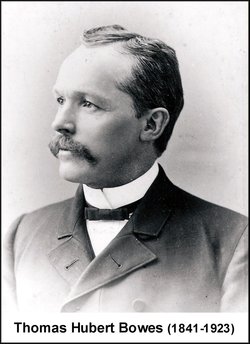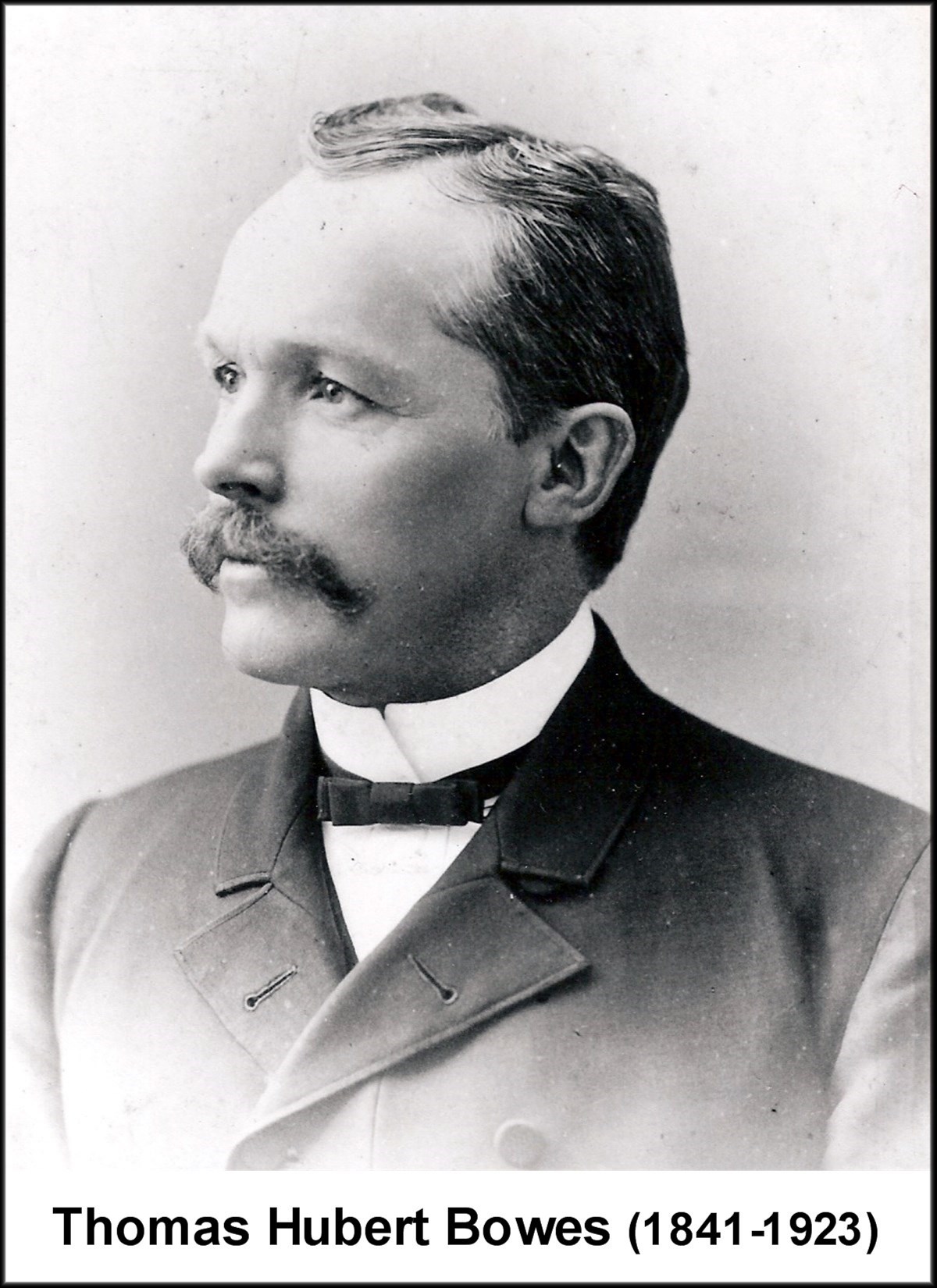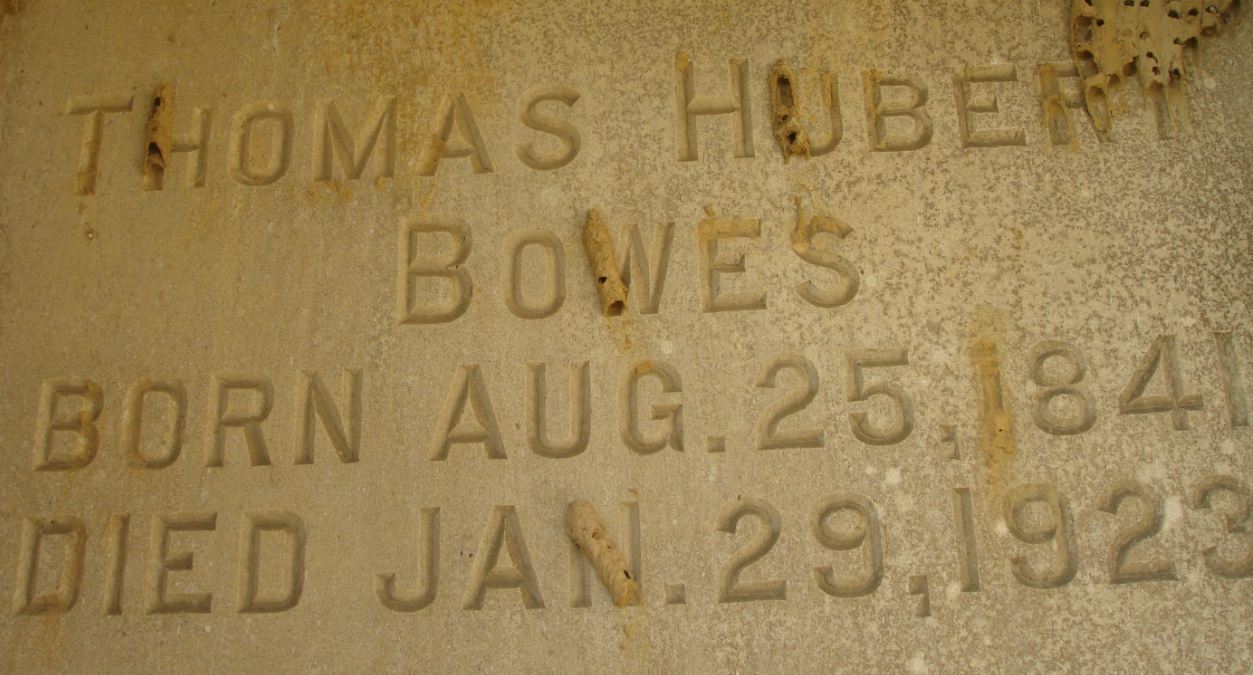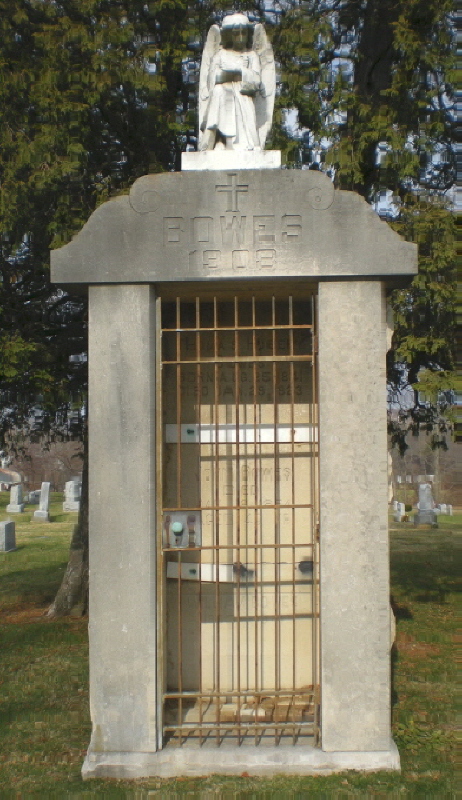The Bowe/Bowes family were part of the mass Irish migration to America because of potato famine in Ireland. The name has been spelled: BOGUE, BOWES, BOWE, BOW, and BOWIE.
Thomas' father, John, sailed from Liverpool, England to America on the ship Forest Monarch arriving on 5 Aug 1848. He is listed on the ship manifest as John Bow, age 37, occupation Laborer, along with a Thomas Bow*, age 20, occupation Laborer.
Thomas, with his mother and siblings, followed his father to America on the ship Fidella, sailing from the port of Liverpool, England arriving on 30 Sep 1848. The ship manifest listed:
-Mary Bow, age 35, occupation Dressmaker
-James Bow, age 16
-Lawrence Bow, age 14
-Kitty Bow, age 12
-Mary Bow, age 10
-Thomas Bow, 8
-Honor Bow, age 6
-Mary Bow *, age 23
*NOTE: It is unknown the exact relationship of Thomas Bow, born about 1828, and Mary Bow, born about 1825. They "may" have been siblings or cousins to John Bowe.
Thomas Bowes was, by today's standard, a self made multimillionaire and bachelor who made his money in his Ohio stores and then Ohio real estate. Evelyn Bowes Tomacci, a grand neice of Thomas Bowes, said in his will, Thomas gave $100 (at the time a 100 days pay) to her father, Thomas Burke Bowes, a nephew of Thomas, as well as all the other nephews and $500 to each niece. The rest of his estate went to the Catholic Church as his sister Maggie Bowes was a teacher and eventually the Mother Superior for the Sisters of the Precious Blood.
ARTICLE
Barquilla de la Santa Maria, Bulletin of the Catholic Record Society - Diocese of Columbus, Ohio, Vol. XXXVIII, No. 8, 18 August, 2013, written by Don Schlegel
On February 21, 1889, what has been called "the First American Catholic Pilgrimage to Rome and the Holy Land" departed from the pier at Hoboken, New Jersey, aboard the steamer Welland. The group would not return until late Spring. Much was made of the trip at the time, but no account was written until almost twenty-five years later, when the only Ohioan to make the pilgrimage had the account published in Columbus. A copy of his 72-page book was recently donated to the Society by Jennifer Fullin of the Family Life Office. The author was Thomas Hubert Bowes.
Bowes was the seventh child and youngest son of John and Mary (Murphy) Bowe, who brought their family from Johnstown, County Kilkenny, Ireland, to Perry County, Ohio, in the late 1840s. They were living in Monday Creek Township in 1850. Thomas was born on August 25, 1841. A young would-be soldier, he enrolled in the 198th Ohio Volunteer Infantry on April 10, 1865 at Camp Chase, west of Columbus. Not enough men signed up for this regiment and the war was ending, however, so the men were mustered out on May 8 without having left Central Ohio. Mr. Bowes was single and seems to have moved around some, but he spent much of the rest of his life in Columbus. In the 1880s he was a dry goods clerk and lived in the vicinity of Town and High. From about 1900 onwards he lived in the vicinity of Fourth Avenue and North High streets. He had his own shoe store in 1901 and his own dry goods store in 1903. He later was a real estate dealer.
The 1889 pilgrimage was organized by Very Rev. Charles A. Vissani, O.S.F., who was the Commissary of the Holy Land, with an office in New York City. The Franciscan Order for centuries had and still has charge of the sacred and historic places in the Holy Land. On February 20 there was an impressive service in the new St. Patrick's Cathedral, when Archbishop Corrigan offered pontifical high Mass and gave his benediction to the departing pilgrims. A handsome silk banner was displayed in the Cathedral on the morning of the departure and was carried by the pilgrims. It bore the American shield, the coat of arms of the Commissary, and the words "First American Pilgrimage to the Holy Land, 1889." It was to be placed on the tomb of the Saviour. Medals also were designed to serve as reminders of the occasion. There were ninety-two pilgrims, including two bishops, 37 other clergymen, and 53 lay people. Of these, 25 were from New York, 16 from New Jersey, and 13 from Massachusetts. (New York Herald, Feb. 19, 1889)
According to Bowes' book, after a stormy beginning, the pilgrims landed safely at Cherbourg. They visited Paris, Marseilles, Nice, Genoa, Pisa, Florence and Assisi before journeying on to Rome. They had an audience with the Holy Father on March 19. Next stops were at Pompeii, Naples, Alexandria, Cairo and the pyramids, and Jaffa, before finally arriving in Jerusalem. When they reached Jerusalem there was some discussion as to whether they should be permitted to carry the American flag through the streets. Bishop Rudemacher, one of the pilgrims, gave permission and Mr. Bowes "had the honor of heading the band of the first American Pilgrims in their marching through the streets of the Holy City and into the Church of the Holy Sepulchre." (There are some odd errors in his sketchy outline of history given at this point.) In the Holy Land, besides all the sites in Jerusalem they visited St. John's of the Desert and the house of St. Elizabeth, Bethlehem, the Dead Sea, and Jericho.
On Easter Sunday, April 21, they attended Mass at the Holy Sepulchre. On the 23rd the group split up for the return journey. Mr. Bowes' part of the group went to Alexandria, Messina, Genoa, Turin, Paris, London; Dublin, Killarney, and Queenstown.
The Bowe/Bowes family were part of the mass Irish migration to America because of potato famine in Ireland. The name has been spelled: BOGUE, BOWES, BOWE, BOW, and BOWIE.
Thomas' father, John, sailed from Liverpool, England to America on the ship Forest Monarch arriving on 5 Aug 1848. He is listed on the ship manifest as John Bow, age 37, occupation Laborer, along with a Thomas Bow*, age 20, occupation Laborer.
Thomas, with his mother and siblings, followed his father to America on the ship Fidella, sailing from the port of Liverpool, England arriving on 30 Sep 1848. The ship manifest listed:
-Mary Bow, age 35, occupation Dressmaker
-James Bow, age 16
-Lawrence Bow, age 14
-Kitty Bow, age 12
-Mary Bow, age 10
-Thomas Bow, 8
-Honor Bow, age 6
-Mary Bow *, age 23
*NOTE: It is unknown the exact relationship of Thomas Bow, born about 1828, and Mary Bow, born about 1825. They "may" have been siblings or cousins to John Bowe.
Thomas Bowes was, by today's standard, a self made multimillionaire and bachelor who made his money in his Ohio stores and then Ohio real estate. Evelyn Bowes Tomacci, a grand neice of Thomas Bowes, said in his will, Thomas gave $100 (at the time a 100 days pay) to her father, Thomas Burke Bowes, a nephew of Thomas, as well as all the other nephews and $500 to each niece. The rest of his estate went to the Catholic Church as his sister Maggie Bowes was a teacher and eventually the Mother Superior for the Sisters of the Precious Blood.
ARTICLE
Barquilla de la Santa Maria, Bulletin of the Catholic Record Society - Diocese of Columbus, Ohio, Vol. XXXVIII, No. 8, 18 August, 2013, written by Don Schlegel
On February 21, 1889, what has been called "the First American Catholic Pilgrimage to Rome and the Holy Land" departed from the pier at Hoboken, New Jersey, aboard the steamer Welland. The group would not return until late Spring. Much was made of the trip at the time, but no account was written until almost twenty-five years later, when the only Ohioan to make the pilgrimage had the account published in Columbus. A copy of his 72-page book was recently donated to the Society by Jennifer Fullin of the Family Life Office. The author was Thomas Hubert Bowes.
Bowes was the seventh child and youngest son of John and Mary (Murphy) Bowe, who brought their family from Johnstown, County Kilkenny, Ireland, to Perry County, Ohio, in the late 1840s. They were living in Monday Creek Township in 1850. Thomas was born on August 25, 1841. A young would-be soldier, he enrolled in the 198th Ohio Volunteer Infantry on April 10, 1865 at Camp Chase, west of Columbus. Not enough men signed up for this regiment and the war was ending, however, so the men were mustered out on May 8 without having left Central Ohio. Mr. Bowes was single and seems to have moved around some, but he spent much of the rest of his life in Columbus. In the 1880s he was a dry goods clerk and lived in the vicinity of Town and High. From about 1900 onwards he lived in the vicinity of Fourth Avenue and North High streets. He had his own shoe store in 1901 and his own dry goods store in 1903. He later was a real estate dealer.
The 1889 pilgrimage was organized by Very Rev. Charles A. Vissani, O.S.F., who was the Commissary of the Holy Land, with an office in New York City. The Franciscan Order for centuries had and still has charge of the sacred and historic places in the Holy Land. On February 20 there was an impressive service in the new St. Patrick's Cathedral, when Archbishop Corrigan offered pontifical high Mass and gave his benediction to the departing pilgrims. A handsome silk banner was displayed in the Cathedral on the morning of the departure and was carried by the pilgrims. It bore the American shield, the coat of arms of the Commissary, and the words "First American Pilgrimage to the Holy Land, 1889." It was to be placed on the tomb of the Saviour. Medals also were designed to serve as reminders of the occasion. There were ninety-two pilgrims, including two bishops, 37 other clergymen, and 53 lay people. Of these, 25 were from New York, 16 from New Jersey, and 13 from Massachusetts. (New York Herald, Feb. 19, 1889)
According to Bowes' book, after a stormy beginning, the pilgrims landed safely at Cherbourg. They visited Paris, Marseilles, Nice, Genoa, Pisa, Florence and Assisi before journeying on to Rome. They had an audience with the Holy Father on March 19. Next stops were at Pompeii, Naples, Alexandria, Cairo and the pyramids, and Jaffa, before finally arriving in Jerusalem. When they reached Jerusalem there was some discussion as to whether they should be permitted to carry the American flag through the streets. Bishop Rudemacher, one of the pilgrims, gave permission and Mr. Bowes "had the honor of heading the band of the first American Pilgrims in their marching through the streets of the Holy City and into the Church of the Holy Sepulchre." (There are some odd errors in his sketchy outline of history given at this point.) In the Holy Land, besides all the sites in Jerusalem they visited St. John's of the Desert and the house of St. Elizabeth, Bethlehem, the Dead Sea, and Jericho.
On Easter Sunday, April 21, they attended Mass at the Holy Sepulchre. On the 23rd the group split up for the return journey. Mr. Bowes' part of the group went to Alexandria, Messina, Genoa, Turin, Paris, London; Dublin, Killarney, and Queenstown.
Family Members
Sponsored by Ancestry
Advertisement
Explore more
Sponsored by Ancestry
Advertisement











